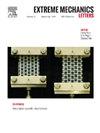Predicting biaxial failure strengths of aortic tissues using a dispersed fiber failure model
IF 4.5
3区 工程技术
Q2 MATERIALS SCIENCE, MULTIDISCIPLINARY
引用次数: 0
Abstract
Despite advances in methods to incorporate patient-specific aortic geometries and tissue elastic properties into computational rupture risk analyses of aortic aneurysms, isotropic failure metrics remain widely used for aortic tissue, which oversimplifies its anisotropic failure characteristics. While classical failure criteria for engineered unidirectional fiber-reinforced composites demonstrate improved performance over isotropic metrics in predicting aortic failure properties, an accurate failure metric tailored to the aorta that accounts for dispersed collagen fiber architecture remains largely undeveloped and requires experimental validation. In this study, we employed a novel dispersed fiber failure metric that considers fiber dispersion and assessed its ability to predict the biaxial failure strengths of the aortic wall. We conducted off-axis uniaxial and planar biaxial failure tests, from which anisotropic failure strengths of aortic tissues were obtained through digital image correlation analysis. The off-axis uniaxial data were used to calibrate the failure model parameters, while the biaxial failure data provided direct experimental validations. Using this approach, we evaluated the performance of two variants of the dispersed fiber failure metric: the dispersed Tsai-Hill and dispersed Hashin-Rotem models, comparing them to their unidirectional counterparts. Results showed that the dispersed Tsai-Hill and dispersed Hashin-Rotem models outperformed their unidirectional counterparts, reducing errors by 33.8 % and 34.3 %, respectively. These findings highlight the significance of incorporating fiber dispersion in models that predict aortic tissue failure.
利用分散纤维衰竭模型预测主动脉组织双轴衰竭强度
尽管将患者特定的主动脉几何形状和组织弹性特性纳入主动脉瘤破裂风险计算分析的方法取得了进展,但各向同性失效指标仍被广泛用于主动脉组织,这过于简化了其各向异性失效特征。虽然工程单向纤维增强复合材料的经典失效标准在预测主动脉衰竭特性方面比各向同性指标表现出更好的性能,但为主动脉量身定制的精确失效指标(考虑分散的胶原纤维结构)在很大程度上仍未开发,需要实验验证。在这项研究中,我们采用了一种新的分散纤维衰竭指标,该指标考虑了纤维弥散性,并评估了其预测主动脉壁双轴衰竭强度的能力。我们进行了离轴单轴和平面双轴破坏试验,通过数字图像相关分析得到主动脉组织的各向异性破坏强度。离轴单轴数据用于校准破坏模型参数,而双轴破坏数据提供了直接的实验验证。使用这种方法,我们评估了分散光纤失效度量的两种变体的性能:分散的Tsai-Hill模型和分散的Hashin-Rotem模型,并将它们与单向模型进行了比较。结果表明,分散的Tsai-Hill模型和分散的Hashin-Rotem模型优于单向模型,分别减少了33.8% %和34.3% %的误差。这些发现强调了在预测主动脉组织衰竭的模型中纳入纤维弥散的重要性。
本文章由计算机程序翻译,如有差异,请以英文原文为准。
求助全文
约1分钟内获得全文
求助全文
来源期刊

Extreme Mechanics Letters
Engineering-Mechanics of Materials
CiteScore
9.20
自引率
4.30%
发文量
179
审稿时长
45 days
期刊介绍:
Extreme Mechanics Letters (EML) enables rapid communication of research that highlights the role of mechanics in multi-disciplinary areas across materials science, physics, chemistry, biology, medicine and engineering. Emphasis is on the impact, depth and originality of new concepts, methods and observations at the forefront of applied sciences.
 求助内容:
求助内容: 应助结果提醒方式:
应助结果提醒方式:


